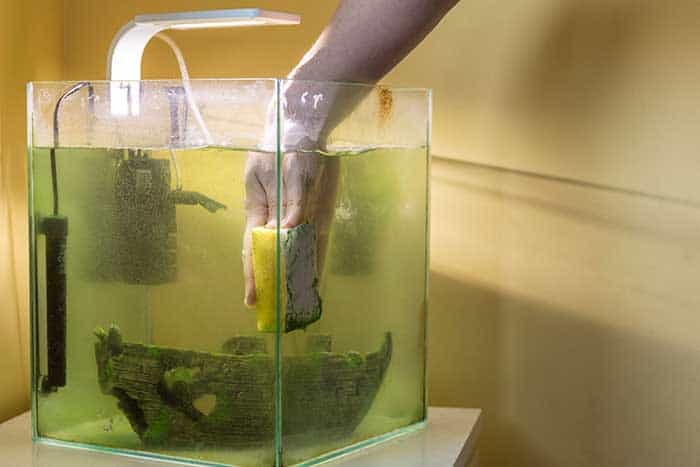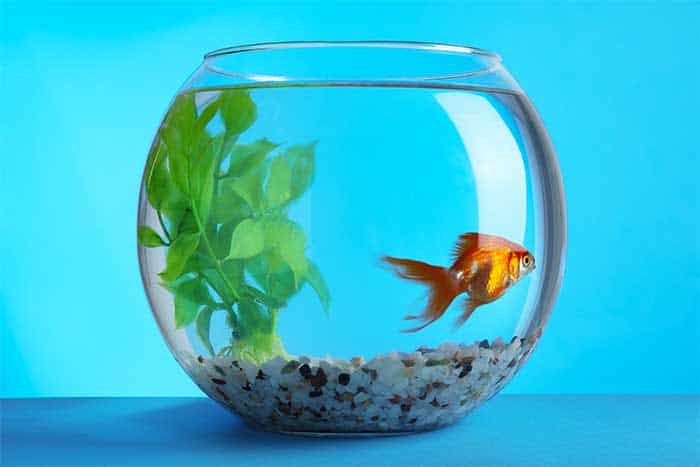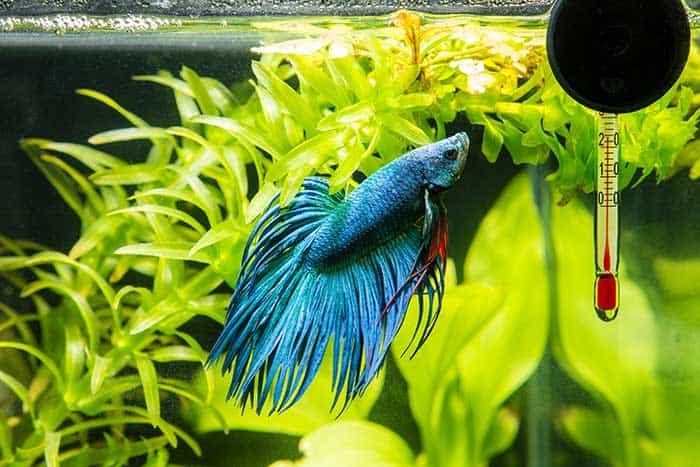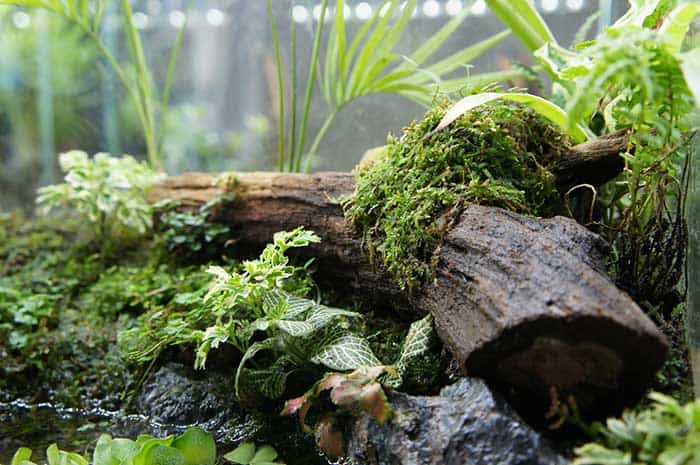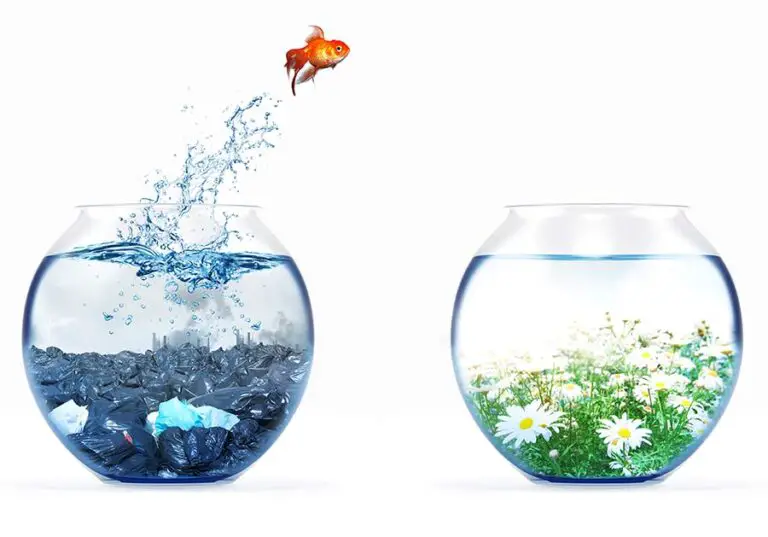How To Clean A Fish Tank With Vinegar (In 9 easy steps)
When cleaning a fish tank, there are many different ways you can go about it. Some people prefer to use chemicals, while others opt for natural solutions. In this guide, I explain how to clean a fish tank with vinegar to get it squeaky clean and looking like new.
Vinegar is an excellent choice for those who want to clean their fish tank safely without harsh chemicals, and it’s also more affordable. The acid in vinegar cuts through grease, slime, and dirt with ease, making short work of calcium deposits and algae buildup.
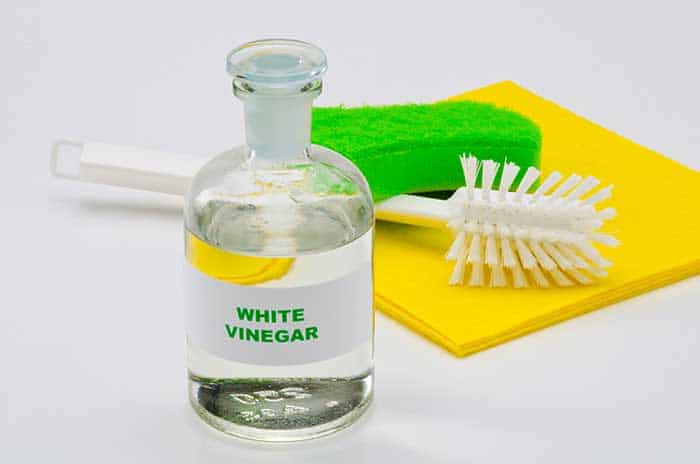
How To Clean A Fish Tank With Vinegar
The steps to clean a fish tank with vinegar are:
- Prepare the fish tank for cleaning. Empty fish tanks are easier to clean, but if your fish are still in the tank, you can either remove them to a separate fish tank or lower the water level to around half. Don’t throw the water away. Just keep it in a bucket and return it after cleaning.
- Choose a natural vinegar that has not been through extra processing or has any additional compounds. Unless you are cleaning an empty tank, the vinegar should contain no more than 5%-6% acetic acid. Distilled white vinegar is an excellent choice.
- Dilute the vinegar into a spray bottle mixed with water. A 5% solution of 1 part vinegar to 20 parts water should be fine when used around fish. If your tank’s pH is already quite alkaline, you can mix a stronger vinegar and water solution of up to 1 part vinegar to 10 parts water. Feel free to mix an even stronger solution if your tank is empty.
- Spray the tank glass with the vinegar mixture. Work in small areas so that you don’t have too much vinegar running off the glass into the water. For an empty tank, you can spray liberally to all tank areas.
- Leave the vinegar to sit for 5 minutes. The acetic acid will help lift grease and loosen dirt as it soaks.
- Wipe away the vinegar with a clean, dry cloth, and repeat the process until all exposed glass has been covered.
- If your tank still has water in it, you can soak a magnetic glass cleaner or an algae pad in some diluted vinegar. This won’t clean as effectively, but it will help.
- Rinse the entire tank with clean water to remove any vinegar residue.
- Replace the water that you removed earlier. This helps to dilute any vinegar that entered the tank. Vinegar is acidic and can alter the pH level, so returning this water also helps the pH level return to normal.
You can also use vinegar to clean and sanitize ornaments, filters, and live plants, which you can learn about here: How To Clean Fish Tank Decorations (The easy way).
How To Clean Aquarium Glass With Vinegar
You can apply the steps above to the entire tank, but you should only spray the exposed glass with vinegar when you have water in the tank.
Don’t spray all the glass at once, as the vinegar can run into the aquarium water; instead, you should work in small areas. If you are limited in space, dip a cleaning cloth into your vinegar solution and apply it to the glass until damp.
Leave the vinegar solution on the glass for 5-15 minutes and wipe it clean. Continue until all exposed glass has been cleaned. You can add a little salt to a moist sponge and lightly scrub for slightly more stubborn stains but don’t do this on acrylic.
You cannot reach the glass below the waterline with a spray, so you need to soak a magnetic glass cleaner in the vinegar solution instead. If you have problems removing built-up stains, you should empty the tank.
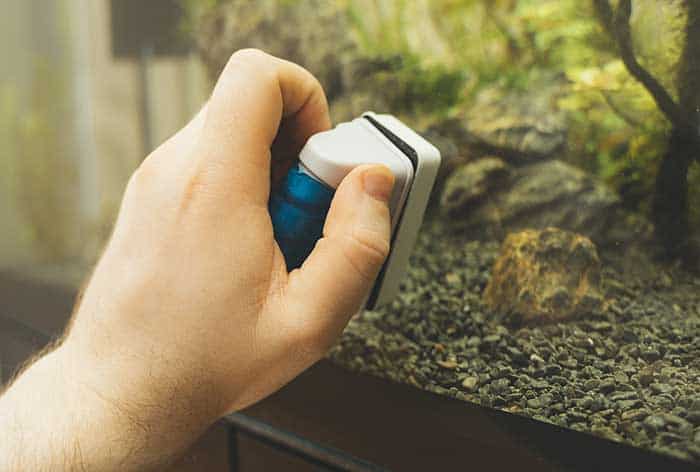
Daily cleaning with a glass cleaning magnet only takes a few minutes and reduces the need for harsher chemicals or vinegar.
Resilient hard water stains, calcium deposits, and other mineral deposits can be scraped off with an algae scraper or a razor blade, which you can learn about in my article: How To Remove Hard Water Stains From Fish Tank (In 6 Steps).
You will need to hold the razor blade flush with the glass, but be careful not to hurt yourself and only use it on the glass. Acrylic fish tanks scratch too easily.
Now you have finished cleaning the internal glass, you need to clean the external glass in the same way. Vinegar leaves a streak-free, crystal-clear viewing experience.
Ensure that you only use a soft cloth or soft brush when cleaning glass, plastic, or acrylic because it can scratch easily and would need to be replaced.
If you have an acrylic fish tank, it will be particularly susceptible to scratching.
How To Clean Aquarium Plants With Vinegar
Whether you have live plants, plastic plants, or silk plants, they all need to be cleaned. Plastic and silk plants are pretty straightforward, they can be sprayed with vinegar and cleaned with a toothbrush. So how do you clean live aquarium plants with vinegar?
Live aquarium plants can be delicate, but they need to be cleaned. Aquatic plants attract a lot of waste, and they can also harbor parasites.
The best way to clean aquarium plants with vinegar is to create a dip. You can make a dip in a shallow bowl and use 1 part vinegar to 10 parts water.
Remove plants carefully, paying particular attention to the roots, which can become deeply entangled within the substrate and are easily damaged.
When dipping your plants in the vinegar solution, make sure the roots are not submerged, as they are very delicate and will soak up the solution, which can damage the entire plant.
You can submerge plants in a vinegar dip for 5 to 15 minutes. You should rinse them thoroughly to remove all vinegar before returning them to the tank.
Before you add new plants to your aquarium, I recommend sanitizing them so that you don’t inadvertently introduce a bunch of snail eggs or parasites into your tank.
Many people with aquarium plants like to use a bleach solution, but regular bleach dipping can be hard on your plants, making vinegar dips are a great substitute.
I have written an entire article about cleaning aquarium plants which I suggest you read for a more in-depth guide: How To Clean Aquarium Plants (Best methods revealed).
How To Clean An Aquarium Filter With Vinegar
When cleaning your fish tank filter, I recommend you only clean the housing with vinegar. The beneficial bacteria that are essential to the health of your tank live and breed within the filter media, and vinegar kills these bacteria on contact.
Killing the beneficial bacteria within your filter may create the need to cycle your tank to promote the growth of fresh bacteria. The sudden growth of new bacteria can also cause your fish tank water to become cloudy due to a bacterial bloom.
The below articles provide plenty of information about cycling and bacterial blooms.
How To Cycle A Fish Tank In 24 Hours.
Why Is My Fish Tank Cloudy After Water Change?
Will Cloudy Water Hurt My Fish?
Vinegar helps remove limescale, algae, and other built-up gunk from the filter housing. Soak the housing in a vinegar solution for 15 minutes and then rinse with clean water.
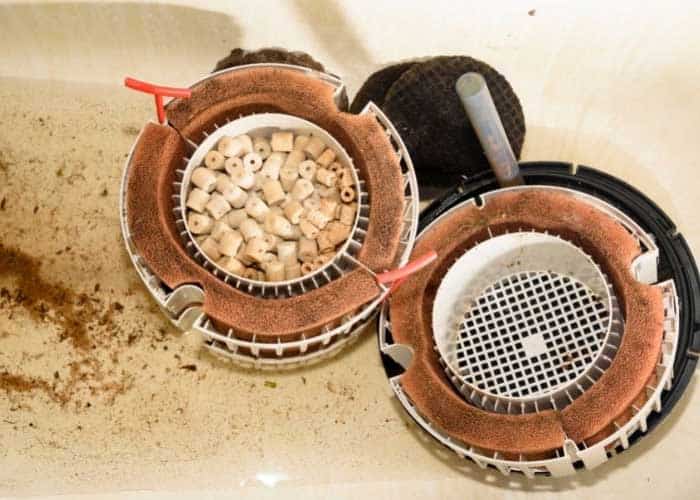
If your filter media is filthy, you can soak it in a bucket of dechlorinated water for an hour before rinsing and returning it to the housing.
I clean my filter media when I do a water change, soaking the filter media in the bucket of tank water after a thorough clean so I don’t lose the delicate bacteria from it. With regular cleaning, you shouldn’t need to do this too often.
Cleaning your aquarium filter is essential for fish tank maintenance and should be done every 4-6 weeks.
How To Clean Fish Tank Ornaments With Vinegar
You can clean aquarium decorations and ornaments with a 10% or 20% vinegar solution. Tank decorations can be sprayed or dipped and should be left to soak in the vinegar for 10-15 minutes.
You should always rinse thoroughly, removing all vinegar residue before returning to the tank.
Regular cleaning with vinegar is unnecessary as clean, warm water will usually suffice, and vinegar is only necessary for more intensive cleaning.
Can You Use Vinegar To Clean A Fish Tank
So we have established that you can use vinegar to clean a fish tank. Many aquarium owners are looking for ways to clean their tanks without harsh chemicals. Vinegar is a natural cleaning product that can be used to clean a fish tank. However, it is essential to use the correct type of vinegar.
White vinegar is the best type to use for cleaning because it is less likely to harm fish and other aquatic creatures. When cleaning with vinegar, it is best to remove all fish from the tank and any other objects that can be damaged by the acidity of the vinegar.
It is possible to clean your tank with vinegar without removing your fish, but its use has some limitations, impacting its effectiveness.
The main concern when using vinegar for fish tank cleaning is the acidity level of the vinegar. If your water is already acidic, the vinegar may increase the acidity beyond a safe level.
Fish tank water has a natural pH value that will be acidic, neutral, or alkaline (basic). Your tank’s pH can be affected if vinegar enters the water. Alkaline water contains buffers that help to neutralize acids and keeps the pH level stable, which you can read about in my article: How To Lower Alkalinity In Fish Tank Water.
As a fish keeper, you should know the approximate pH of your fish tank’s water, but a simple test can tell you. A neutral to slightly alkaline pH will tolerate a small amount of vinegar entering the water without drastically altering its pH. Never pour vinegar directly into your tank.
Can You Use Apple Cider Vinegar to Clean a Fish Tank
Vinegar has been used for many purposes for hundreds of years. Vinegar appears to be quite a versatile product, often praised for its excellent cleaning ability and medical applications (among other things). More recently, apple cider vinegar has been raved about, mainly for its health benefits, so what is the difference between apple cider vinegar and white vinegar, and can you use apple cider vinegar to clean a fish tank?

The two main differences between apple cider vinegar and white vinegar are their acetic acid potency and how the acetic acid is created. White vinegar can have an acetic acid content of between 5% to 20%, whereas apple cider vinegar usually has between 5%-6% acetic acid.
Apple cider vinegar is fermented from apples, sugar, and yeast. White vinegar is mainly fermented from grains, molasses, whey, sugar beets, or potatoes, where the sugar and yeast are added to start the fermentation process.
Both white vinegar and apple cider vinegar are very natural products that can be used in a fish tank, but it’s the acetic acid content that provides its cleaning benefits.
Distilled white vinegar with an acetic acid content of 10%-20% is not for consumption and is generally used for cleaning applications.
Whether using apple cider vinegar or white vinegar for cleaning a fish tank, I would recommend using no greater than 5%-6% acetic acid content.
The fermentation process for apple cider vinegar creates different enzymes that are not present in white vinegar. Some research has suggested that these enzymes provide added health benefits. Apple cider vinegar can be more expensive and provides no added cleaning benefit to your fish tank.
Is Vinegar Harmful To Fish
Used correctly, vinegar won’t harm your fish. Vinegar is only harmful to fish if it comes into direct contact with them, as the acid content can cause burns. If vinegar enters the water undiluted, it can dramatically alter its pH, causing shock.
If you are cleaning your fish tank with vinegar while your fish are still inside, it is vital to avoid getting any vinegar on them. The best way to do this is to remove as much water from the tank as possible and dilute the vinegar to the recommended safe level.
How To Clean An Old Empty Fish Tank With Vinegar
Vinegar is ideal for cleaning an old fish tank and can make it look like new in no time.
You can apply a strong vinegar solution to the entire tank, inside and out, and leave it to soak for as long as necessary. I will often use straight vinegar, completely undiluted, as it will not cause any harm.
There are no real limitations when cleaning an empty tank, except that you should remove all the vinegar by rinsing it thoroughly before using it. Although not a significant problem, vinegar residue that remains on the glass can affect the pH of the tank water when you are trying to cycle it from new.
If stains on your old tank are difficult to remove, gently scrub the glass with a soft toothbrush or algae pad. Acrylic fish tanks can scratch very easily, so you may need to use vinegar with up to 20% acetic acid or a specialized cleaning solution.
Below is a short video I found on Youtube that will show you the power of vinegar on harsh stains and mineral deposits.
Will Vinegar Kill Algae In Fish Tank
Vinegar kills algae in a fish tank, but you should never add vinegar directly to the tank. Vinegar can cause irritation to fish, disrupt your fish tank pH levels, and kill beneficial bacteria, leading to a dangerous spike in ammonia. High ammonia levels in a fish tank can kill fish quickly.
Algae should be pretty easy to remove with some gentle brushing. Ornaments and decor that are coated in algae should be removed from the tank before applying vinegar. Rinse thoroughly in clean water before returning to the tank.
Wrap Up
So you have learned that vinegar can have many applications when cleaning a fish tank. It is generally much safer to use when compared to some cleaning chemicals.
Vinegar is cheap and readily available, so you won’t need to purchase specific cleaning solutions that may cost a fortune.
When using vinegar to clean your fish tank, always remember to take extra care not to harm your fish. Remove as much water as possible, and be sure to rinse everything thoroughly before returning anything to the tank.


